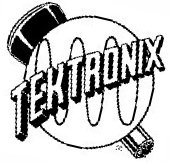 The Museum
of Tek Scopes
The Museum
of Tek Scopes 
 The Museum
of Tek Scopes
The Museum
of Tek Scopes 
Welcome to the Museum of old Tektronix Scopes. These pages give information
on and images of old Tektronix scopes up to about 1970. They were
originally created by Arnoud Vanderwel, who no longer had the time to
mantain them, so I have taken them over.
NOTE- You can click the pictures if you want more detail than the thumbnails.
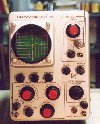 Type 310.
The type 310 was a small scope in its day, and was one of the first Tek
instruments to make use of printed circuit boards. Interestingly, they
were dropped in the 310A, which reverted back to the tried and tested
ceramic strip construction. It was built until 1958. This particular one,
s/n 4468 is used in experiments with Tesla coils. Its owner: "A solid
state scope just wont survive for long in that kind of high RF pulse
environment. I needed a rugged tube type scope and this fit the bill
perfectly. Being all tube its very rugged and not prone to failures from
transients or surges." For some neat pictures of Tesla coils in action,
see Mike Hammer's page (URL in the Credits section). Mike once more:
"I find it amazing that something over 40 years old can be in such fine
shape and still function so well. A testament to the ruggedness and
workmanship of these scopes." Contributed by Mike Hammer
Type 310.
The type 310 was a small scope in its day, and was one of the first Tek
instruments to make use of printed circuit boards. Interestingly, they
were dropped in the 310A, which reverted back to the tried and tested
ceramic strip construction. It was built until 1958. This particular one,
s/n 4468 is used in experiments with Tesla coils. Its owner: "A solid
state scope just wont survive for long in that kind of high RF pulse
environment. I needed a rugged tube type scope and this fit the bill
perfectly. Being all tube its very rugged and not prone to failures from
transients or surges." For some neat pictures of Tesla coils in action,
see Mike Hammer's page (URL in the Credits section). Mike once more:
"I find it amazing that something over 40 years old can be in such fine
shape and still function so well. A testament to the ruggedness and
workmanship of these scopes." Contributed by Mike Hammer  Type 321.
The type 321 is the first battery powered scope that Tektronix
produced. It is almost completely solid-state and weighs less than 9
kg, definitely a featherweight compared to the other Tek scopes of the
era. The 321 was made until 1964, when it was succeeded by the 321A.
Contributed by Evert Fruitman
Type 321.
The type 321 is the first battery powered scope that Tektronix
produced. It is almost completely solid-state and weighs less than 9
kg, definitely a featherweight compared to the other Tek scopes of the
era. The 321 was made until 1964, when it was succeeded by the 321A.
Contributed by Evert Fruitman 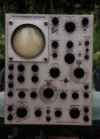 Type
512. The Type 512 is a very early Tek instrument, the last examples of
which left the factory in 1953. At the time, it cost $950. At the moment,
they are very rare, though no doubt there are still a number sitting
around in the back of labs around the world waiting to be 'discovered'
by collectors. This particular example (#2206) was long owned by Norman
Peacock, and is now part of Bernard Tichit's collection.
Type
512. The Type 512 is a very early Tek instrument, the last examples of
which left the factory in 1953. At the time, it cost $950. At the moment,
they are very rare, though no doubt there are still a number sitting
around in the back of labs around the world waiting to be 'discovered'
by collectors. This particular example (#2206) was long owned by Norman
Peacock, and is now part of Bernard Tichit's collection.
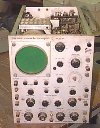 Type
524D. This photograph was taken by A. P. Vanderwel of an oscilloscope in
the back of a dusty lab in Lusaka, long since forgotten. He writes
" The fan had been
removed to no doubt do something more useful than sit in an inoperative
oscilloscope. It was the first Tek I ever saw from the brown-era.
I immediately thought of taking this scope home and restoring it, but
reason got the better of me just in time, and I had to leave it. It must
still be there. Tom Buchanan tells me: The 524 is old-old-old. It was
old in 1966 when I went to work for Tek. It was a TV scope but very hard
to sync. I don't think anyone even remembers the circuits anymore. The
tubes would be hard to get."
Type
524D. This photograph was taken by A. P. Vanderwel of an oscilloscope in
the back of a dusty lab in Lusaka, long since forgotten. He writes
" The fan had been
removed to no doubt do something more useful than sit in an inoperative
oscilloscope. It was the first Tek I ever saw from the brown-era.
I immediately thought of taking this scope home and restoring it, but
reason got the better of me just in time, and I had to leave it. It must
still be there. Tom Buchanan tells me: The 524 is old-old-old. It was
old in 1966 when I went to work for Tek. It was a TV scope but very hard
to sync. I don't think anyone even remembers the circuits anymore. The
tubes would be hard to get." 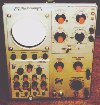 Type
533A. A very beautiful scope, Made from 1960 to 1972. Weight: 31 Kg. Power
consumption: approx. 500 W. Tube count: approx. 50. Though it has a bandpass
of "only" 15MHz, this is never in practice a serious limitation,
and certainly not when used for audio work. This scope accepts all the
Tek "Letter" and "1" series plug-ins, making it a very
versatile instrument. Mine is S/N 100353, i.e. the 252nd instrument off
the production line. All the 530, 540 and 580 series scopes are equipped
with more or less the same LT supply (LT, i.e. -150, 100, 225, 350 and
500 V) which is equipped with a 5651 reference voltage drop tube, a pair
of 6080's and four 12B4's. Here it is seen in
the 533A.
Type
533A. A very beautiful scope, Made from 1960 to 1972. Weight: 31 Kg. Power
consumption: approx. 500 W. Tube count: approx. 50. Though it has a bandpass
of "only" 15MHz, this is never in practice a serious limitation,
and certainly not when used for audio work. This scope accepts all the
Tek "Letter" and "1" series plug-ins, making it a very
versatile instrument. Mine is S/N 100353, i.e. the 252nd instrument off
the production line. All the 530, 540 and 580 series scopes are equipped
with more or less the same LT supply (LT, i.e. -150, 100, 225, 350 and
500 V) which is equipped with a 5651 reference voltage drop tube, a pair
of 6080's and four 12B4's. Here it is seen in
the 533A. 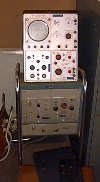 Type
536. This is a 10 MHz X-Y scope, that can be fitted with two letter or
1 type plugins for high frequency X-Y measurements. This one is fitted
with a T Time base plugin, that allows the scope to be used as a general
purpose scope. Also note the handy little cart that we find this scope
on... :)
Type
536. This is a 10 MHz X-Y scope, that can be fitted with two letter or
1 type plugins for high frequency X-Y measurements. This one is fitted
with a T Time base plugin, that allows the scope to be used as a general
purpose scope. Also note the handy little cart that we find this scope
on... :)  Type 545. This is a rather
old 545, as can be seen by the black leather handles. Long time top of the line
540 series scope, the 545, dual timebase 30 MHz scope was later succeeded by A
and B versions. Addittional pictures show the bottom and
right side of the instrument. On this second picture, you can
see the 'door' that holds the second timebase and trigger circuits, that is found on all
5x5 instruments.
Contributed by Robert Bernstein
Type 545. This is a rather
old 545, as can be seen by the black leather handles. Long time top of the line
540 series scope, the 545, dual timebase 30 MHz scope was later succeeded by A
and B versions. Addittional pictures show the bottom and
right side of the instrument. On this second picture, you can
see the 'door' that holds the second timebase and trigger circuits, that is found on all
5x5 instruments.
Contributed by Robert Bernstein
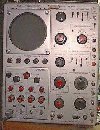 Type 547 with 1A4 plug-in.
Probably the greatest of the classic Tek scopes, the 547 has dual timebases
with delayed sweep and a unique "alternate" function. The 547 has a very stable
trigger circuit and is useful well beyond its rated 50 MHz bandwidth. This is
the model to look for if you're buying a 500-series instrument.
Contributed by Bruce Rogers
Type 547 with 1A4 plug-in.
Probably the greatest of the classic Tek scopes, the 547 has dual timebases
with delayed sweep and a unique "alternate" function. The 547 has a very stable
trigger circuit and is useful well beyond its rated 50 MHz bandwidth. This is
the model to look for if you're buying a 500-series instrument.
Contributed by Bruce Rogers
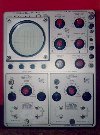 The 551 shown here is one of the
largest Teks. It comes with a separate power supply (not shown) that holds a
full 5 6080's and supplies the 551 mainframe with regulated DC power. The 551 is a
true dual beam instrument, that can hold two plugins, and has a bandwidth of about 24
MHz. When equipped with two 4-channel plugins, 8-channel displays are a real possibility,
though probably of limited use, with less than 1 cm of vertical deflection per channel. On
this picture, you can see the right hand vertical (distributed)
amp and delay line.
Contributed by Robert Bernstein
The 551 shown here is one of the
largest Teks. It comes with a separate power supply (not shown) that holds a
full 5 6080's and supplies the 551 mainframe with regulated DC power. The 551 is a
true dual beam instrument, that can hold two plugins, and has a bandwidth of about 24
MHz. When equipped with two 4-channel plugins, 8-channel displays are a real possibility,
though probably of limited use, with less than 1 cm of vertical deflection per channel. On
this picture, you can see the right hand vertical (distributed)
amp and delay line.
Contributed by Robert Bernstein
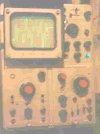 Type
564. One of the world's first commercially marketed storage scopes.
Brian Kline writes:
"I would argue that the Hughes 104 Memo scope probably preceded the
Tektronix 564 as a commercial product. It was a mostly if not
entirely vacuum tube design using printed circuit boards. The biggest
problem with the 104D was it's limited bandwidth of about 300 KHz."
Unfortunately, neither of us knows when the 104D was made, so we are
unable to ascertain which one gets the "first" label. What I do know is that
the bistable storage technique came from Hughes originally, so the Hughes Memo
scope might indeed have been first.
Made until 1968, the type 564 is a bit smaller than the others. It accepts Tek 2-
and 3- series plugins, and has a bandpass of approximately 10 MHz, when
equipped with the right plugins. This scope does not have a fan, but it
seems to cope quite well without, judging by the fact that it is still
working.
Type
564. One of the world's first commercially marketed storage scopes.
Brian Kline writes:
"I would argue that the Hughes 104 Memo scope probably preceded the
Tektronix 564 as a commercial product. It was a mostly if not
entirely vacuum tube design using printed circuit boards. The biggest
problem with the 104D was it's limited bandwidth of about 300 KHz."
Unfortunately, neither of us knows when the 104D was made, so we are
unable to ascertain which one gets the "first" label. What I do know is that
the bistable storage technique came from Hughes originally, so the Hughes Memo
scope might indeed have been first.
Made until 1968, the type 564 is a bit smaller than the others. It accepts Tek 2-
and 3- series plugins, and has a bandpass of approximately 10 MHz, when
equipped with the right plugins. This scope does not have a fan, but it
seems to cope quite well without, judging by the fact that it is still
working.  Type 567. This "560" series scope accepts
2 and 3 series plugins and is seen equipped with 3S1 and 3T4 sampling
plugins. It also has space for a readout unit that can display waveform
attributes like pulse width or voltage and make pass/fail comparisons to preset values.
Contributed by Bruce Rogers
Type 567. This "560" series scope accepts
2 and 3 series plugins and is seen equipped with 3S1 and 3T4 sampling
plugins. It also has space for a readout unit that can display waveform
attributes like pulse width or voltage and make pass/fail comparisons to preset values.
Contributed by Bruce Rogers
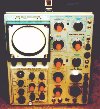 Type
585A. The peak of Tube scope technology? This fine instrument was made
from 1963 to 1972. At the time, it cost US$2600, without plugins. This
machine has a bandpass of no less than 85 MHz! Weight: 37 Kg. Power consumption:
approx. 630 W. Tube count: slightly over 80, neon bulbs not counted. More
a technological wrestling match than a great scope in day to day repair
work, this machine is equipped with no less than 15 6DJ8's in the vertical
amp, forming a distributed amplifier to give it its 85 MHz bandpass.
Curious? This is what
te bottom half of the distributed amp looks like. Mine is S/N 700400, i.e.
built in Heerenveen, the Netherlands. When I found this scope, sometime
early in 1996, I found all 80 of the tubes to be in working condition,
and two of the four transistors in the machine to be defective. So: tubes?
unreliable? Difficult to find? You try finding a replacement 2N277!
Type
585A. The peak of Tube scope technology? This fine instrument was made
from 1963 to 1972. At the time, it cost US$2600, without plugins. This
machine has a bandpass of no less than 85 MHz! Weight: 37 Kg. Power consumption:
approx. 630 W. Tube count: slightly over 80, neon bulbs not counted. More
a technological wrestling match than a great scope in day to day repair
work, this machine is equipped with no less than 15 6DJ8's in the vertical
amp, forming a distributed amplifier to give it its 85 MHz bandpass.
Curious? This is what
te bottom half of the distributed amp looks like. Mine is S/N 700400, i.e.
built in Heerenveen, the Netherlands. When I found this scope, sometime
early in 1996, I found all 80 of the tubes to be in working condition,
and two of the four transistors in the machine to be defective. So: tubes?
unreliable? Difficult to find? You try finding a replacement 2N277!  Type 453. This scope does
not really belong in the list of the great Tek scopes. This 50MHz portable
scope was included because the 453 was one of the last Tek designs to
use vacuum tubes - a pair of Nuvistors in the input channels. Later
453s went to FET inputs. The 453 is a great general purpose bench or
portable scope with a bright, sharp trace that looks better than many
newer models! Contributed by Bruce Rogers
Type 453. This scope does
not really belong in the list of the great Tek scopes. This 50MHz portable
scope was included because the 453 was one of the last Tek designs to
use vacuum tubes - a pair of Nuvistors in the input channels. Later
453s went to FET inputs. The 453 is a great general purpose bench or
portable scope with a bright, sharp trace that looks better than many
newer models! Contributed by Bruce Rogers When looking at Tek instruments of the vacuum tube era, we find only two curve tracers. These were the 570 and the 575.
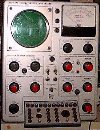 Type 570 Vacuum-Tube
Characteristic-Curve Tracer. This rare instrument is the 575's counterpart for
testing vacuum tubes. The unit was provided with a set of various tube sockets
which can be installed and jumpered to the appropriate test points. Tubes can
be checked for gain and matched if desired. Contributed by Bruce Rogers
Type 570 Vacuum-Tube
Characteristic-Curve Tracer. This rare instrument is the 575's counterpart for
testing vacuum tubes. The unit was provided with a set of various tube sockets
which can be installed and jumpered to the appropriate test points. Tubes can
be checked for gain and matched if desired. Contributed by Bruce Rogers
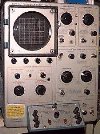 Type 575 Transistor Curve Tracer.
The standard instrument for characterizing
transistors for many years, one of them sits upon my workbench and sees regular
use testing everything from FETs to tunnel diodes -- the 575 is still a very useful instrument for
testing and comparing transistors and diodes. The unit shown has option 122C,
extending the maximum voltage to 400V. The 575 can be coupled with a Type 175 adapter
to extend its current capabilities for power devices. Contributed by Bruce Rogers
Type 575 Transistor Curve Tracer.
The standard instrument for characterizing
transistors for many years, one of them sits upon my workbench and sees regular
use testing everything from FETs to tunnel diodes -- the 575 is still a very useful instrument for
testing and comparing transistors and diodes. The unit shown has option 122C,
extending the maximum voltage to 400V. The 575 can be coupled with a Type 175 adapter
to extend its current capabilities for power devices. Contributed by Bruce Rogers
Most of the Tek scopes of this era were plug-in scopes, i.e. they had
an interchangeable vertical input amp. The two most common plug-in types
for these scopes are the "Letter" series, which later became
the "1" series, and the 2/3 series.
The difference between 2 and 3 series plugins is that only the 2 series
can be used in the 560 scope. Reason is power draw, the 560 had a very
feeble power supply. The 561, 561A, 561B, 564, 564B, 567, and 568 can
use 2 or 3 series.
Also, the 2 and 3 series were the successors to the 60 and 70 series,
with the same restrictions. The 60 and 70 series plugins were renumbered
by adding 2A/2B and 3A/3S/3T prefixes as appropriate. There were also a
few 50 series plugins (50, 51, 59) with very limited functionality, really
for some dedicated applications.
There are also some other (less common) plugins, for example
the "80" series, and the "9" "10" and "11"
series. Tek also made several non-plugin scopes.
 Type
CA. This is a two channel all-tube plugin which is interesting, because
when the 533A is equipped with it, there is not a single transistor left
in the whole machine. It is not interesting because it is a very good amplifier,
because it isn't. Though usable, it suffers from extensive DC drift while
warming up, and unfortunately, the input selector switches do not have
a "GND" position, so there is no quick way to reset the trace
to the middle of the graticule, short of disconnecting the probe, which
is a drag.
Type
CA. This is a two channel all-tube plugin which is interesting, because
when the 533A is equipped with it, there is not a single transistor left
in the whole machine. It is not interesting because it is a very good amplifier,
because it isn't. Though usable, it suffers from extensive DC drift while
warming up, and unfortunately, the input selector switches do not have
a "GND" position, so there is no quick way to reset the trace
to the middle of the graticule, short of disconnecting the probe, which
is a drag. 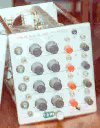 Type
M. This is a four channel amp that works fine except that the 1A4 works
better (see below).
Type
M. This is a four channel amp that works fine except that the 1A4 works
better (see below). 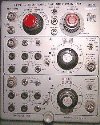 Type O Operational Amplifier
Plug-In. This unusual device plugs into any 530-540-550
scope mainframe. It provides two (vacuum-tube!) op amps whose input and feedback
impedances are selected by rotary knobs or plugged into the panel. The user can
implement filters, integrators, differentiators, or gain blocks and display
the output on the scope. Contributed by Bruce Rogers
Type O Operational Amplifier
Plug-In. This unusual device plugs into any 530-540-550
scope mainframe. It provides two (vacuum-tube!) op amps whose input and feedback
impedances are selected by rotary knobs or plugged into the panel. The user can
implement filters, integrators, differentiators, or gain blocks and display
the output on the scope. Contributed by Bruce Rogers
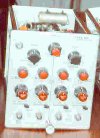 Type
1A4. This is also a four channel amp, and one that works very well. With
the right scope (like a 547) it has a bandpass of up to 50 MHz. It can
chop, alt, or add in any possible way between the four channels, and
handy "ident" buttons help you identify what's what when you
have four traces on screen.
Type
1A4. This is also a four channel amp, and one that works very well. With
the right scope (like a 547) it has a bandpass of up to 50 MHz. It can
chop, alt, or add in any possible way between the four channels, and
handy "ident" buttons help you identify what's what when you
have four traces on screen.  Type
1A7. A very sensitive (10uV/cm) differential amp that also has switchable
high- and lowpass filters, and a CMRR of >110dB (!).Very nice, for the
sort of applications that require this sort of plugin. For example, you
can use this plugin to measure the open loop gain of an audio amp directly,
by measuring on the + and - inputs of input stage.
Type
1A7. A very sensitive (10uV/cm) differential amp that also has switchable
high- and lowpass filters, and a CMRR of >110dB (!).Very nice, for the
sort of applications that require this sort of plugin. For example, you
can use this plugin to measure the open loop gain of an audio amp directly,
by measuring on the + and - inputs of input stage.
As with all old electronics, the availability of manuals is a crucial point in terms of usability and repairability. Fortunately, Tek manuals are not (very) hard to find if you know where to look. After all, every Tek scope used to come with two complete operating, service and calibration manuals (!). These manuals are of truly excellent quality, with extensive sections on troubleshooting and repair, and a complete circuit description that explains the working of your scope in detail. A must-have for your old Tek.
This section still needs to be expanded. If you feel you are able to contribute please send me an email. I am especially, but not exclusively, interested in tunnel diode trigger circuits and bistable storage oscilloscopes. If you are an (ex-) Tek engineer who was involved in the production of any of these oscilloscopes and or the development of any of the circuits and techniques used in them then you are of course especially invited to contribute.
So: If you have any questions, additions, corrections, or want to swap anything, get in touch, and we'll talk Tek.
and........

Pages mantained by Alan Bain, please feel free to contact me with extra information or corrections.